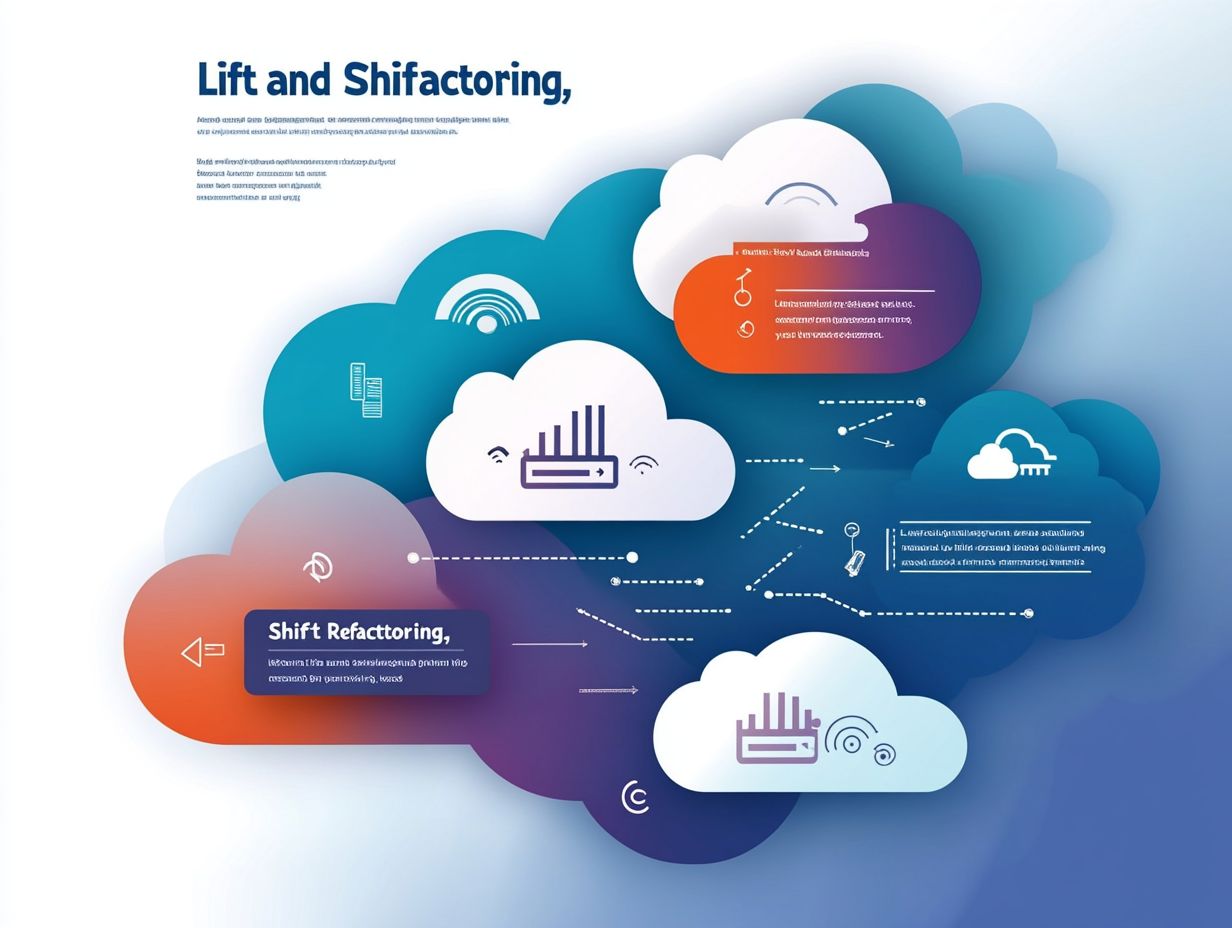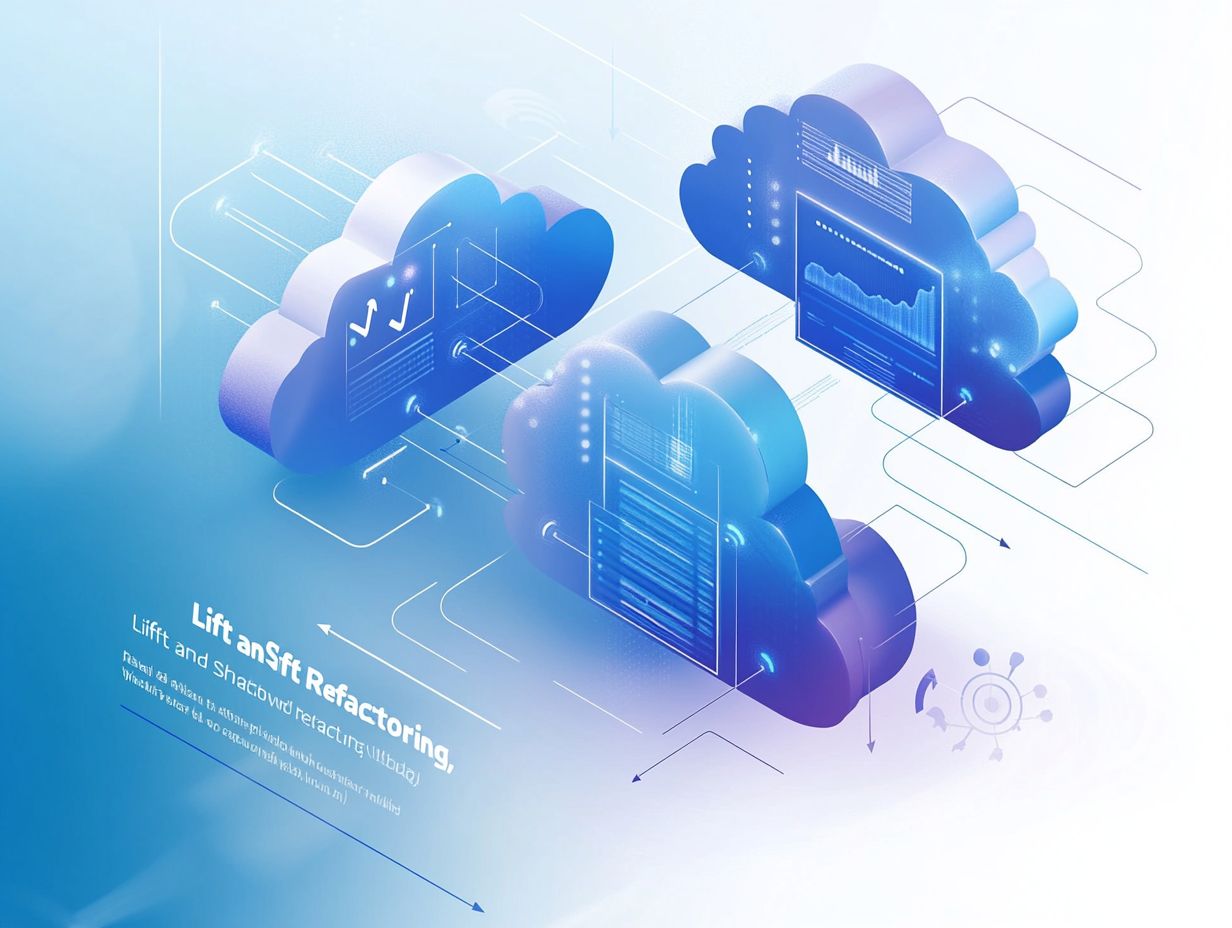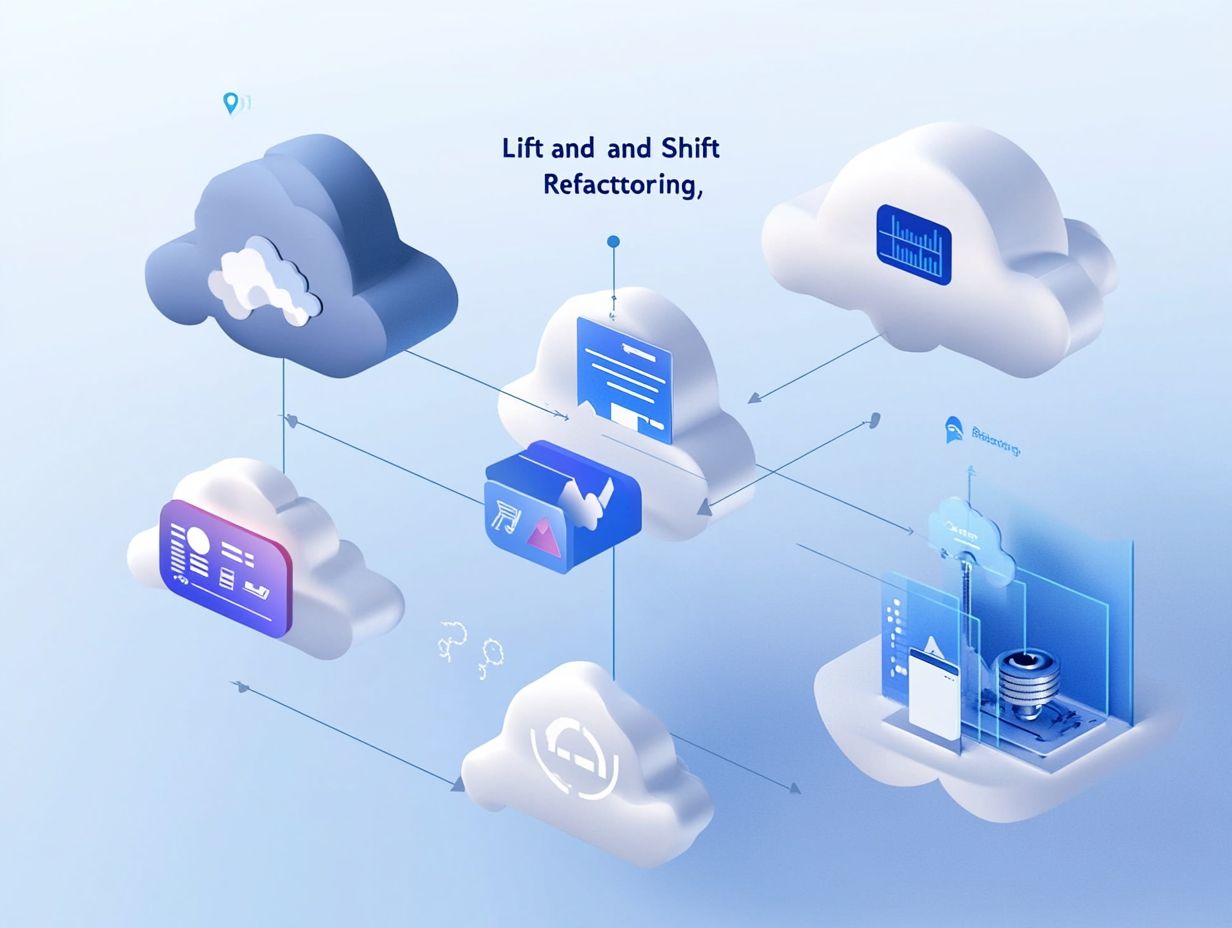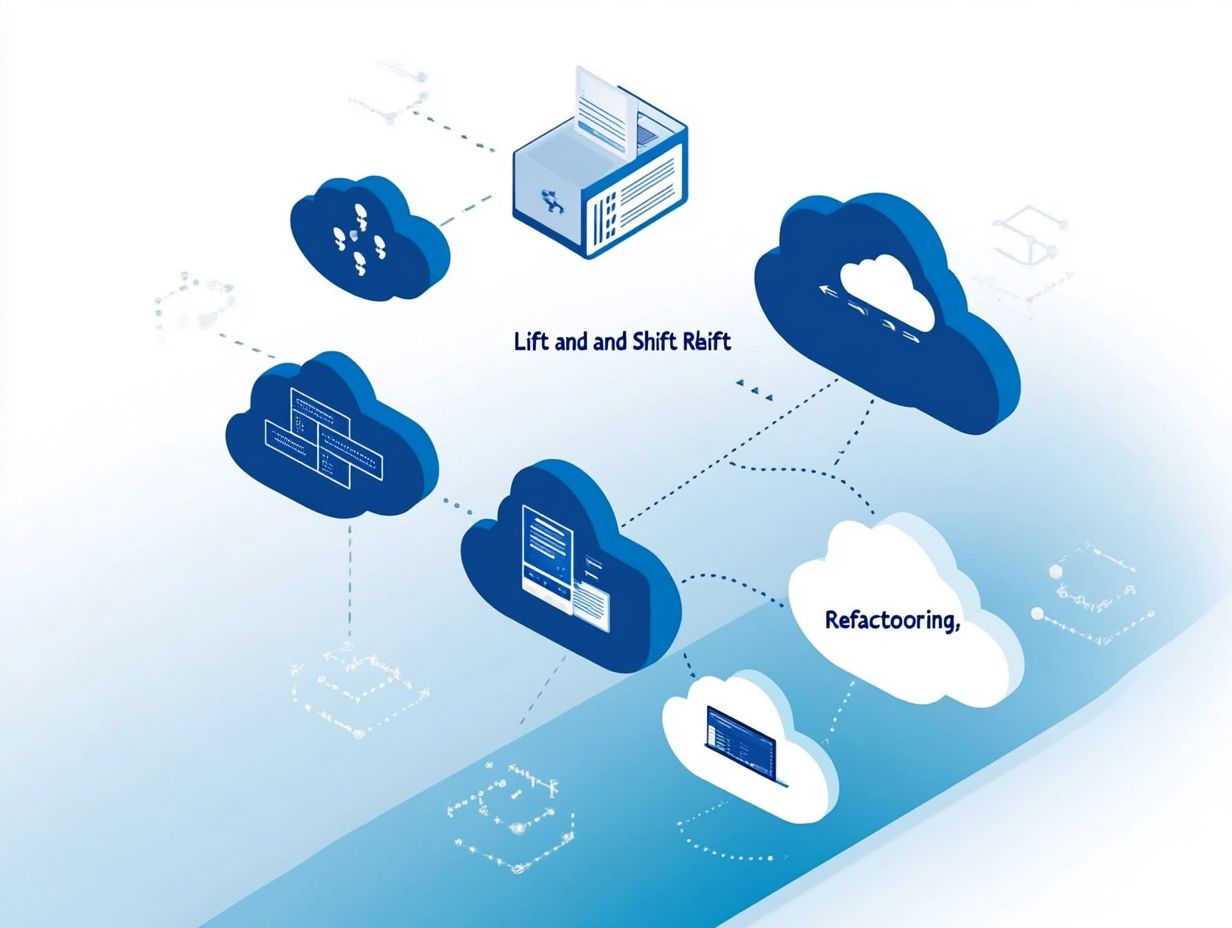5 Hybrid Cloud Migration Strategies
Navigating the complexities of hybrid cloud migration may feel overwhelming, but understanding the various strategies available can significantly ease the process.
This article explores fifteen distinct approaches, from “Lift and Shift” to “Reimagining,” each tailored to meet diverse business needs.
It also covers important considerations, factors to keep in mind when choosing workloads, common challenges, and valuable tips for ensuring a seamless transition.
By the end, you will have the insights necessary to make informed decisions on your cloud journey.
Contents
- Key Takeaways:
- 1. Lift and Shift
- 2. Rehosting
- 3. Replatforming
- 4. Refactoring
- 5. Rebuilding
- 6. Repurchasing
- 7. Retiring
- 8. Retaining
- 9. Replacing
- 10. Replicating
- 11. Reimagining
- 12. Releasing
- 13. Reintegrating
- 14. Reassessing
- 15. Reevaluating
- What Is Hybrid Cloud Migration and Why Is It Important?
- Frequently Asked Questions
- What are the 5 Hybrid Cloud Migration Strategies?
- What is lift and shift in Hybrid Cloud Migration?
- How does shift and optimize work in Hybrid Cloud Migration?
- What is hybrid cloud bursting in Hybrid Cloud Migration?
- What is Data and Application Integration in Hybrid Cloud Migration?
- What are Managed Services in Hybrid Cloud Migration?
Key Takeaways:

- Hybrid cloud migration combines on-premises and cloud benefits, boosting flexibility and scalability.
- Before choosing a migration strategy, businesses should consider factors such as cost, security, and compatibility with existing systems.
- A thorough assessment of workloads is crucial to determine which ones are suitable for migration to the cloud.
1. Lift and Shift
Lift and Shift is a cloud migration strategy that allows you to transition applications and data to the cloud with minimal adjustments. This approach maximizes efficiency and reduces infrastructure costs while leveraging cloud services.
This method lets you deploy quickly, allowing you to respond to changing market dynamics. It also significantly reduces the risks associated with migrating critical workloads, ensuring operational continuity as you focus on other strategic initiatives.
Incorporating Lift and Shift into your broader cloud strategy lays a solid foundation for future enhancements and innovations. As you embark on your cloud journey, consider long-term sustainability and how this initial migration aligns with your ongoing cloud optimization efforts to stay competitive in an ever-evolving digital landscape.
2. Rehosting
Rehosting, often referred to as ‘lift and shift,’ involves moving your application from on-premises to the cloud without major changes. This approach helps maintain efficiency while quickly adapting to a cloud environment.
By making this transition, you can quickly access cloud resources while keeping disruptions to a minimum. The benefits of rehosting are noteworthy:
- You gain increased scalability, allowing you to respond quickly to changing demands without managing physical servers.
- Flexibility enables a quicker reaction to market needs.
It’s essential to assess your cloud applications to ensure they perform optimally in this new setup. This involves optimizing resource allocation and identifying potential bottlenecks that could arise during the migration process.
3. Replatforming
Replatforming focuses on fine-tuning your applications during cloud migration, ensuring you harness cloud technology effectively. This strategic move can lead to significant cost savings and seamless integration.
This approach enhances performance by optimizing applications for the cloud environment and offers scalability that traditional hosting methods cannot provide.
Unlike rehosting, where applications are transferred as-is, replatforming allows you to utilize cloud-native features, maximizing efficiency and responsiveness.
This process is pivotal in your company’s digital transformation journey, laying the foundation for modern infrastructure and enabling faster innovation while aligning IT resources more effectively with your business objectives.
4. Refactoring
Refactoring is a cloud migration strategy that invites you to re-architect your applications. This approach helps you leverage cloud-based tools, enhancing performance and scalability.
By adopting this strategy, you optimize your resources and improve disaster recovery and data management. You ll respond to disruptions more quickly and manage data more intuitively.
Embracing transformative technologies requires robust training for your employees. This ensures they gain the skills needed to navigate new tools effectively.
Establishing performance metrics is essential for evaluating the success of refactoring. This allows teams to refine processes and achieve desired outcomes.
5. Rebuilding
Rebuilding means completely redesigning your applications for the cloud. This harnesses cloud technology to boost performance and drive business growth.
This process is crucial when legacy systems limit your flexibility, scalability, or integration with new technologies.
By adopting a design specifically made for cloud computing, you modernize your infrastructure and respond better to market changes. As you rebuild, you ll enhance operational efficiency, streamline workflows, and reduce resource consumption.
Monitor metrics like application response time and user satisfaction to gauge effectiveness. Regular assessments fine-tune your strategies to ensure continuous improvement.
6. Repurchasing
Repurchasing, or transitioning to Software as a Service (SaaS), lets you leverage existing cloud services while improving your vendor selection process.
This strategy significantly reduces infrastructure costs, eliminating hefty investments in physical hardware.
Such a transition streamlines your cloud deployment and enhances flexibility, allowing you to adapt to business demands seamlessly.
You must carefully assess your customer needs when selecting a vendor. This ensures the chosen solution aligns with your goals and delivers expected value.
Take the time to find the best vendor to maximize your resources. A thoughtful approach can lead to improved efficiency and a competitive advantage.
7. Retiring

Retiring involves phasing out legacy applications that no longer serve a purpose. This process enhances operational efficiency and ensures cloud readiness.
It requires evaluating current usage patterns to determine if an application is actively used or a productivity bottleneck.
Compliance with regulatory standards is vital in deciding the fate of each application. Any application that fails to meet these standards poses risks to your organization.
Discontinuing outdated systems unlocks cost savings and allows for more effective resource allocation. This transition streamlines operations and cultivates agility.
8. Retaining
Retaining certain applications during cloud migration helps maintain control over critical data and ensures compliance with data security regulations.
This assessment is essential; it optimizes how well things work and mitigates risks related to data breaches or loss of functionality.
By evaluating performance metrics and security protocols, you can identify vital applications for daily operations and foster a seamless migration process.
An effective strategy includes conducting a thorough inventory of existing applications, analyzing their utility, and prioritizing those that align with your goals.
Engaging teams across IT and compliance facilitates informed decision-making, allowing you to retain applications that ensure continuity and promote a smooth transition to the cloud.
9. Replacing
Replacing outdated applications with modern cloud-based tools is crucial for your cloud migration journey. It enables you to enhance business operations and foster deeper customer engagement.
By choosing to replace rather than simply upgrade, you can make it easier to connect your systems. This strategic approach reduces the cost of reworking old code to meet new standards and allows your organization to swiftly adapt to shifting market dynamics.
With cloud solutions at your fingertips, you can leverage real-time data analytics to refine customer interactions and personalize your offerings. These advancements align perfectly with your digital transformation goals, ensuring that all stakeholders remain connected and engaged throughout the entire process.
10. Replicating
Replicating applications within a cloud environment significantly enhances your disaster recovery capabilities. It protects your vital business operations from unexpected outages while ensuring a robust cloud architecture and effective data storage solutions.
This practice fosters organizational agility, allowing you to respond swiftly to shifting market conditions. By maintaining multiple replicas of critical applications, you can uphold performance guarantees that instill confidence in your clients and stakeholders alike.
It’s essential to regularly test and monitor these replicated systems. This enables you to fine-tune your recovery strategies and ensure seamless functionality in the event of a crisis.
Such proactive measures can dramatically reduce downtime and bolster your overall resilience, enabling your business to adapt and thrive in an ever-evolving landscape.
11. Reimagining
Reimagining your applications during cloud migration enables you to align with your current business growth strategies. You can address customer needs through innovative solutions that streamline your operations and position your business to leverage cutting-edge technologies.
By actively incorporating customer feedback into the redesign of your applications, you can create user-centered solutions. Such engagement fuels a continuous cycle of improvement, allowing you to fine-tune features and functionality that enhance the user experience.
Ultimately, this strategic approach fosters digital transformation and cultivates a distinct competitive advantage. It ensures your offerings remain relevant and impactful in an ever-evolving market landscape.
12. Releasing
Releasing applications in a cloud environment after migration is not just vital it’s an exciting opportunity to optimize performance and ensure your users are thrilled with their experience. This phase confirms that your applications operate seamlessly in their new setting and sets the stage for ongoing enhancements and flexibility.
Monitoring continuously is crucial, enabling you to pinpoint performance bottlenecks and user experience issues in real time. By integrating technical support during this critical phase, you can swiftly tackle any challenges that arise, minimizing downtime and boosting user satisfaction.
As your applications progress, regular updates and feedback become essential. This ensures alignment with your business goals and user needs, ultimately driving greater operational efficiency.
13. Reintegrating
Reintegrating applications into an optimized cloud architecture is essential for enhancing your operational efficiency. This process streamlines your workflows and allows you to fully harness the potential of your cloud investments.
You must conduct integration testing immediately to ensure everything works smoothly and minimizes disruptions during the transition. Monitoring after migration is just as vital; it ensures that any issues that pop up post-reintegration are swiftly identified and resolved.
By leveraging advanced cloud technology, you can automate these monitoring processes. This grants you real-time insights into your application s performance and stability.
Ultimately, this approach creates a robust environment where your applications can thrive and adapt to the ever-evolving business landscape. Take these steps now to ensure your applications thrive in the cloud!
14. Reassessing

Reassessing your applications and their performance metrics after migration is crucial for effective cloud cost management and optimizing your business operations.
By systematically evaluating key performance criteria such as response times, resource utilization, and error rates you can pinpoint issues and areas ready for improvement.
This diligent process ensures that your applications align with your business goals. It also fosters a proactive approach to how you allocate resources.
Embracing continuous assessment within a cloud environment delivers amazing benefits, including enhanced efficiency, reduced costs, and better user experiences!
This ongoing evaluation helps you adapt swiftly to changing demands, ensuring your cloud resources remain in sync with your growth strategies.
15. Reevaluating
What factors should you consider before reevaluating your cloud strategies? Understanding their impact on performance metrics is essential for driving business growth.
This process requires a thorough analysis that goes beyond immediate results. You must consider various elements such as current market trends and new technologies.
Assess how shifts in consumer behavior and expectations influence your cloud solutions. Evaluating your competitive positioning in relation to cloud services can provide insights into necessary adjustments.
It s also crucial to explore how innovations like AI and machine learning can enhance how well your business runs and user experience.
By adopting a holistic approach, you can refine your cloud strategies and future-proof your operations against swift industry changes.
What Is Hybrid Cloud Migration and Why Is It Important?
Hybrid cloud migration offers you the best of both worlds, combining the benefits of public and private clouds to enhance your data security, scalability, and flexibility while aligning perfectly with your cloud adoption strategy.
This approach enables you to optimize your resources effectively, allowing you to manage varying workloads with ease. By harnessing the strengths of both environments, your organization can achieve better operational results, minimize downtime, and maintain business continuity even during peak demands.
However, transitioning to a hybrid cloud system isn t without challenges. You may encounter integration complexities and compliance issues along the way.
To navigate these hurdles successfully, it’s essential to adopt best practices like thorough planning, involving stakeholders, and implementing continuous monitoring.
This way, you can ensure a seamless migration process that sets your organization up for success.
What Are the Key Factors to Consider Before Choosing a Migration Strategy?
When you’re selecting a cloud migration strategy, it’s essential to weigh key factors such as customer needs, regulatory compliance, and potential cost savings, especially when considering the top 3 cloud migration methodologies to ensure a seamless transition.
Assessing these factors requires a collaborative approach where you gather input from various stakeholders, including your IT teams, department heads, and end-users. Engaging these groups offers invaluable insights into their specific requirements, leading to a more customized strategy.
Conducting a thorough risk analysis is equally vital. By identifying potential challenges and addressing them proactively, you safeguard the migration process.
Aligning your migration strategy with your broader business objectives not only streamlines implementation but also maximizes the advantages of using hybrid migration strategies, enabling your organization to thrive in an increasingly competitive landscape.
How Can a Business Determine Which Workloads to Migrate to the Cloud?
Determining which workloads to migrate to the cloud requires assessing your existing applications and evaluating their compatibility with cloud technology. You also need to understand their impact on your overall business operations and performance metrics.
Understanding your resource usage is key to a successful migration. Use monitoring tools to gain insights into CPU, memory, and I/O performance.
Establish performance benchmarks to measure application efficiency and user experience both before and after migration.
A well-structured migration roadmap is crucial. It outlines the steps for a seamless transition, addresses potential risks, and provides a comprehensive strategy for managing resources effectively throughout the process.
What Are the Common Challenges in Hybrid Cloud Migration?
Hybrid cloud migration presents several challenges your organization faces, including data security concerns and cloud integration complexities.
To address data security, implement strong encryption and strict access controls to protect sensitive information in transit and at rest.
For cloud integration complexities, adopt standardized APIs and middleware solutions to ensure seamless communication between your on-premises systems and cloud resources.
Strengthen your disaster recovery protocols by establishing regular backup routines and conducting simulation drills. This keeps you prepared for unexpected disruptions.
Tackle these challenges with smart strategies, including how to develop a cloud migration strategy, to navigate the hybrid cloud successfully and minimize associated risks.
How Can a Business Ensure a Smooth and Successful Migration?
To ensure a seamless and successful migration, implement a comprehensive cloud strategy that includes employee training, rigorous testing, and 7 steps to a successful cloud migration with continuous monitoring throughout the process.
Proactive planning is essential for identifying potential challenges before they arise. Engaging stakeholders early fosters ownership and enhances your decision-making process.
Technical support is equally essential during this transition, providing vital resources and expertise to swiftly address unforeseen issues.
Together, these components create a cohesive framework that mitigates risks and positions you to fully harness the advantages of cloud technology.
Frequently Asked Questions

What are the 5 Hybrid Cloud Migration Strategies?
The 5 Hybrid Cloud Migration Strategies are: lift and shift, shift and optimize, hybrid cloud bursting, data and application integration, and understanding multi-cloud migration strategies, along with managed services.
What is lift and shift in Hybrid Cloud Migration?
Lift and shift is a migration strategy that moves applications from on-premises infrastructure to the public cloud without changing the application architecture. This allows for a faster migration process but may not fully utilize the cloud’s capabilities.
How does shift and optimize work in Hybrid Cloud Migration?
Shift and optimize is a migration strategy that involves moving applications to the cloud with modifications to optimize them for the cloud environment. This can include refactoring or rewriting applications for better performance and cost efficiency.
What is hybrid cloud bursting in Hybrid Cloud Migration?
Hybrid cloud bursting is a migration strategy where an application’s workload is shared between an on-premises data center and a public cloud. This allows for using additional resources in the cloud during peak periods while utilizing on-premises infrastructure for everyday use. Implementing disaster recovery strategies for hybrid cloud can further enhance this approach.
What is Data and Application Integration in Hybrid Cloud Migration?
Data and application integration is a method to easily transfer data and applications between on-premises systems and the cloud. This creates a hybrid environment where you can access data and applications from both locations.
What are Managed Services in Hybrid Cloud Migration?
Managed services is an exciting method that lets experts handle your cloud migration! This includes planning, implementing, and maintaining your hybrid cloud environment.






